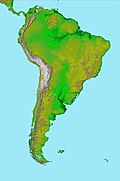San Rafael orogeny
Appearance
The San Rafael orogeny was an orogeny that affected parts of western Argentina and Chile during the Late Paleozoic. The resulting orogenic belt has a NW-NNW curved form.[1] The San Rafael orogeny might have been linked with the roughly contemporary Gondwanide orogeny of eastern Argentina. Parts of the Choiyoi Group sediments were deformed by the San Rafael orogeny.[2] During the Neogene ancient faults related to the San Rafael orogeny conditioned the geometry of the blocks affected by the Andean orogeny.[1]
Some of the plutons of the Elqui-Limarí Batholith were emplaced a context of crustal thickening derivative of the San Rafael orogeny.[2]
References
[edit]- ^ a b Giambiagi, Laura; Mescua, José; Bechis, Florencia; Hoke, Gregory; Suriano, Julieta; Spagnotto, Silvana; Moreiras, Stella Maris; Lossada, Ana; Mazzitelli, Manuela; Toural Dapoza, Rafael; Folguera, Alicia; Mardonez, Diego; Pagano, Diego Sebastián (2016). "Cenozoic Orogenic Evolution of the Southern Central Andes (32–36°S)". In Folguera, Andrés; Naipauer, Maximiliano; Sagripanti, Lucía; Ghiglione, Matías C.; Orts, Darío L.; Giambiagi, Laura (eds.). Growth of the Southern Andes. Springer. pp. 63–98. ISBN 978-3-319-23060-3.
- ^ a b Kleiman, Laura E.; Japas, María S. (2009). "The Choiyoi volcanic province at 34°S–36°S (San Rafael, Mendoza, Argentina): Implications for the Late Palaeozoic evolution of the southwestern margin of Gondwana". Tectonophysics. 473 (3–4): 283–299. doi:10.1016/j.tecto.2009.02.046. hdl:11336/75328. Retrieved 5 January 2016.

